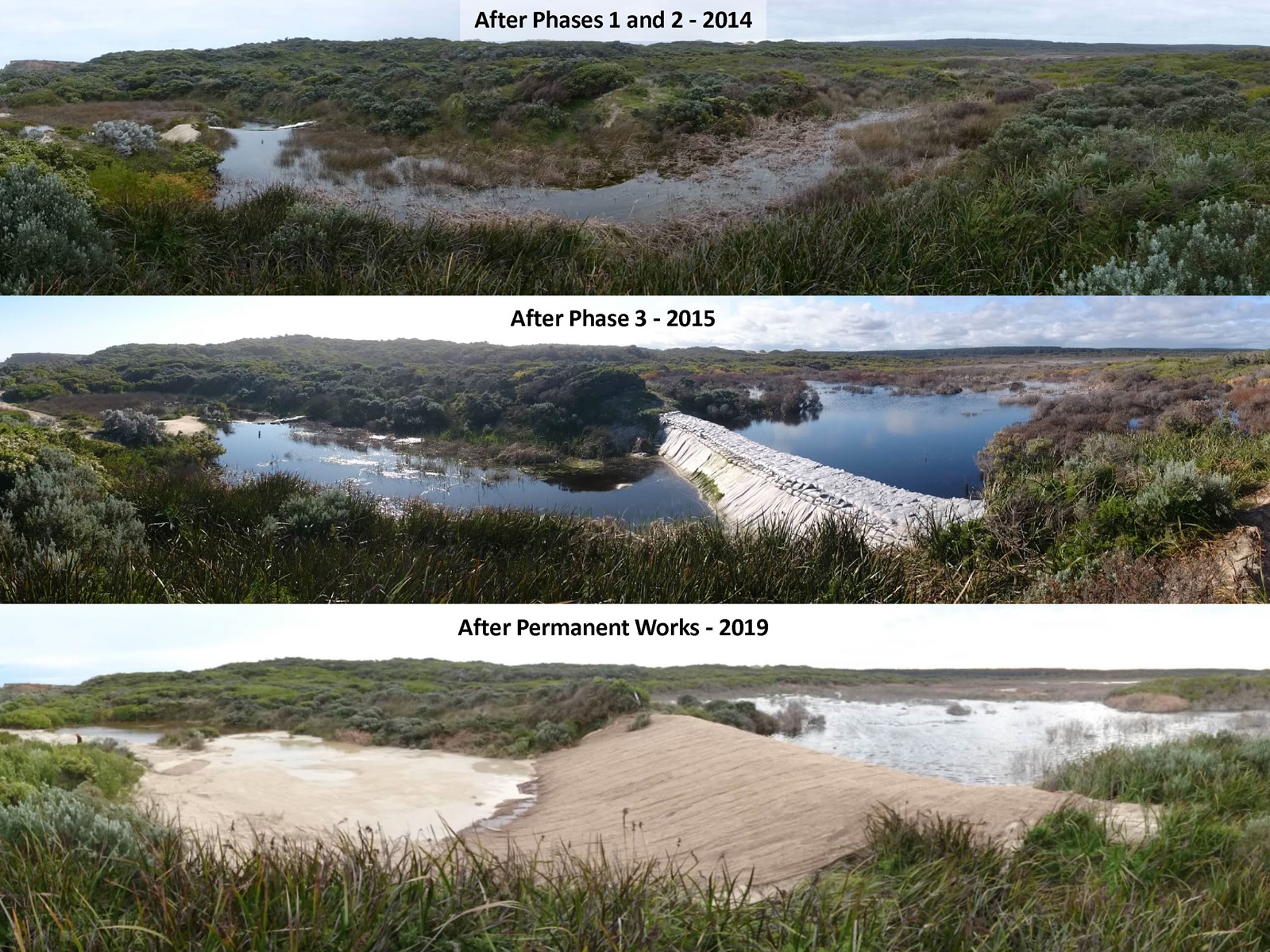NGT’s on-ground works at Nobles Rocks: permanent restoration of Long Swamp
It’s been a long time coming …
Over winter and early spring of this year, NGT implemented the final major on-ground works at Nobles Rocks, permanently blocking the artificial channel and securing the hydrological restoration of Long Swamp, in Discovery Bay Coastal Park (near Nelson, Victoria).
The three year project (2019-2021), made possible by a Biodiversity On-ground Action grant from the Victorian Government, builds on investigations, trial structures and monitoring efforts (outlined in detail here). After the positive ecological response to these trials, the focus shifted to converting the most recent trial structure into a permanent, reinstated sand dune.
Rebuilding the dune was not a regular construction project, and required some creative engineering. The design was finalised in an earlier project run by NGT wetland ecologist Tessa Roberts, with the well-established 7000 sandbag structure re-purposed to become the permanent solid ‘core’ of the reformed dune. More than 500 cubic metres of sand was to be added and shaped to form a sloping dune that, in time, will blend into the natural coastal landscape.
The project area is culturally significant for the local Gunditjmara people, and ecologically sensitive, and with challenges to ensure the works protected these values. The lowest impact method for moving very large quantities of sand was to pump it from the beach, over the dunes, before being shaped into its final form. NGT worked with Gunditj Mirring Traditional Owners Aboriginal Corporation to avoid any impacts to a significant shell midden on the old access track, instead moving machinery along the beach.
After the complex task of moving sand pumps and pipes to the site, the sand finally got moving. A couple of weeks later, including some stops and starts due to the unpredictable weather on this wild bit of southern coastline, the pumping and shaping was complete, and jute matting was rolled over the whole structure to help hold it in place. More than 500m3 of sand makes for a significant change, and the resulting dune is pretty impressive!

Spending so much time on site in a wild and diverse environment led to some interesting fauna sightings. There were almost daily appearances by multiple curious (and nationally endangered) Australasian Bittern – reinforcing that, as a result of our restoration work, Long Swamp is once again a stronghold for the species. We also saw numerous Great Egret and other waterbirds working the moving water for fish, when sand pumping was in progress. There were short-finned eels at the surface of Bully Lake (the original name of the permanent water body that has now been recreated at Nobles Rocks), a couple of coastal echidnas and wallabies, and a possible orca sighting offshore. Seeing a group of Magpie Geese settling in reeds right next to the structure shortly after the works felt like a sign of approval!
Now that construction is finished, we will continue to monitor the ecological response, and revegetate the site to speed up the natural regeneration and dune stabilisation process. Luckily for us, the coastal vegetation at the site quickly colonises and stabilises bare patches; our trial structures were covered with native vegetation only a couple of years after construction. To give the new dune a head start, NGT staff and volunteers planted local coastal species to bind the sand together, and applied brush matting to protect plants and further stabilise the dune.
Thanks to all who have been involved in the Long Swamp restoration story so far – a long list that includes DELWP, the Glenelg Hopkins CMA, Parks Victoria, Gunditj Mirring Traditional Owners Aboriginal Corporation, Glenelg Shire Council, Nelson Coastcare Group, Friends of the Great South West Walk, our sand pumping contractors Dave and Dale – who went above and beyond to complete the job to the high standard needed, and the many volunteers, staff and other supporters who have pitched in or supported the project.
This investment in locally-driven, large-scale wetland restoration outcomes has achieved great things for the Glenelg Estuary and Long Swamp Ramsar site, and we’re looking forward to monitoring the continued recovery of Long Swamp, and watching the recent works blend in to the coastal landscape!


